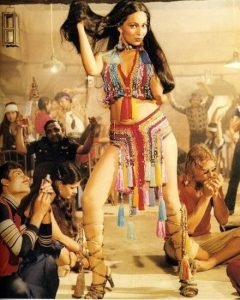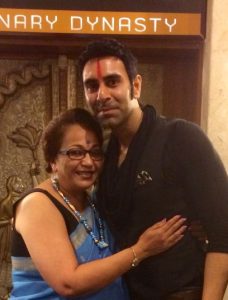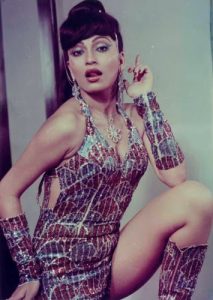I Want to Act Again, says Kalpana Iyer

If I mention iconic Bollywood numbers like Hari Om Hari from Pyaara Dushman (1980), Tu Mujhe Jaan Se Bhi Pyaara Hai from Wardaat (1981), or Rambha Ho Ho Ho from Armaan (1982), what comes to your mind? For me, these unforgettable item numbers of the 1980s instantly bring up images of one dazzling and electrifying performer — Kalpana Iyer. Her hip-swaying moves, captivating presence, and sheer magnetism made her an unforgettable part of Bollywood’s golden era.
To me, Kalpana Iyer was more than just a dancer—she was the epitome of glamour, grace, and unapologetic sensuality. She inherited the legacy of the item number from legends like Helen, Bindu, and Aruna Irani, yet carved a niche all her own. Throughout the 1980s, she was a staple in almost every big film, setting the screen ablaze with her magnetic performances. But Kalpana ji wasn’t just a dancing vamp—her acting chops were evident in films like Satte Pe Satta (1982), Anjaam (1994), Raja Hindustani (1996), and Hum Saath Saath Hain (1999). Her performance as a prison warden in Anjaam, where her character meets a dramatic end at the hands of Madhuri Dixit’s character, was particularly acclaimed.
As a Bollywood choreographer, I’ve always been deeply fascinated by the item songs of the 1970s and 1980s. I’ve had the good fortune of meeting the iconic Helen ji several times, thanks to her daughters Alvira and Arpita Khan, who are my students. But Kalpana Iyer always remained a dream, a legend I admired from afar. There was something ineffable about her, a divine connection I felt, even though we’d never met. Her larger-than-life persona on screen felt incredibly personal to me.
Thanks to the magic of social media, that dream finally came true. To my absolute delight, I connected with Kalpana ji on a networking site. Today, she lives in Dubai with her sister and nephew, On a recent trip to Dubai, I made it a point to visit and meet her in person.
As I walked towards her, anticipation and emotion welled up inside me. The moment I touched her feet, she embraced me warmly, and I found myself crying uncontrollably. I couldn’t understand if it was the sheer joy of meeting a lifelong idol or the realization of a connection that had transcended distance and time. We spoke for hours. There she was—the 1978 Miss India finalist, still exuding charm, elegance, and the spirit of a true star.
I asked her if she had formal dance training, considering her remarkable control and expression on screen.
She smiled and replied, “No formal training at all. I joined a Bharatnatyam class as a child but couldn’t continue due to financial constraints. Everything I know is self-taught—instinctive.”
When I asked how she managed to deliver so many hit dance numbers without training, she responded with a deep sense of humility. “I danced from the time I was a baby,” she said. “Stage was my teacher. It instilled discipline, punctuality, and confidence. I never needed too many rehearsals—I just absorbed everything I observed. My choreographers were my gurus, and I followed them with complete faith.”
When I asked her to name her favorite song, she laughed, “That’s impossible! How can I pick just one? Jab Chaye Mera Jadoo was my first, so it’s very close to my heart. Hari Om Hari was my first solo. Each number has its own story and memory. They are all special.”
She had nothing but praise for the choreographers she worked with. “We called them dance masters then. Each one was different, each one unique. They shaped me. I owe them everything.”
Was there ever a dance that proved too difficult? “Never,” she smiled. “Tough? Yes. Painful? Of course—swollen feet, sore knees—but never too difficult. Especially in the South, perfection was non-negotiable. But I loved that rigor. It made the success even sweeter.”
Has she missed the limelight since stepping away? “Oh yes,” she admitted. “I’d be lying if I said no. I miss everything—the camera, the set, the people. But time moves on. Today’s generation is doing beautiful work, and I bless them with all my heart.”
And who does she admire among today’s stars? “Priyanka Chopra and Deepika Padukone—they’re sheer elegance in motion. Kareena and Katrina impress me with their dedication. And Hrithik Roshan—he brings tears to my eyes. He’s a dancer like no other. Among choreographers, Prabhu Deva stands out—he’s a risk-taker, and that sets him apart.”
Were there any songs she wished she could’ve danced to? “So many,” she said wistfully. “But I’ve had a fulfilling journey. I’m grateful.”
As I left her presence, I couldn’t stop thinking about how this one woman, in a time when heroines shied away from sensuality, dared to redefine what it meant to be a female performer in Bollywood. From beauty queen to bold vamp, from dancing diva to character actor, and finally, to restaurateur living a quiet life in Dubai—Kalpana Iyer has lived many lives with dignity, courage, and grace.
Her story is one of inspiration—for dancers, for dreamers, for anyone who’s ever wanted to express themselves freely and fearlessly. She reminds us that while the spotlight may shift, true talent never fades. And as she watches the next generation take the stage, she does so with love in her heart and blessings on her lips.
Kalpana Iyer—forever a star, forever a fan.
Sandip Soparrkar holds a doctorate in world mythology folklore from Pacific University USA, an honorary doctorate in performing arts from the National American University, He is a World Book Record holder, a well-known Ballroom dancer and a Bollywood choreographer who has been honored with three National Excellence awards, one National Achievement Award and Dada Saheb Phalke award by the Government of India. He can be contacted on sandipsoparrkar06@gmail.com






